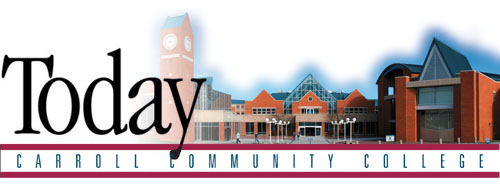
| Spring 2005, No. 19 |
ContentsCarroll is Fastest-growing Community College in Maryland over Past Five Years Dr. Pappalardo Named One of Maryland’s Top 100 Women Carroll Installs Life-Saving Devices throughout Campus Spring Enrollment at Record High Recent Institutional Research Reports College to Host Open House Tuesday May 3rd Student Profile: Michelle Shrader
|
| Carroll Installs Life-Saving Devices throughout Campus |
||
|
By Sylvia Blair The American Heart Association estimates that sudden cardiac arrest contributes to about 250,000 deaths annually in the United States. In an effort to reverse this sobering statistic locally, Carroll Community College has installed automated external defibrillators (AEDs) in strategic locations around the 1601 Washington Rd. campus in Westminster. Dr. Faye Pappalardo, president of the college, believes AEDs can prevent unfortunate incidents on college campuses. “At an institution where I formerly worked, a young woman was struck by sudden cardiac arrest. Although a nurse was called, we did not have an AED to assist the victim. Unfortunately, she died on campus. As a result, I decided that I would support measures here at Carroll to assist a victim experiencing a similar emergency. With the installation of AEDs at Carroll, we are able to decrease our response time to an event,” she said. In cases of sudden cardiac arrest, life or death is a matter of time. Research shows that for each minute that passes without defibrillation, the chances of survival decrease by about ten percent. AEDs offer the immediate action that can save lives. Until emergency medical services arrive on the scene, the only effective treatment for sudden cardiac arrest is early defibrillation. AEDs, hung in alarmed wall cabinets, deliver stored electrical energy to shock a victim’s heart back into normal rhythm. “Carroll has joined a trend in higher education to provide these life-saving devices,” said Stevie Krumrine, risk manager at the college who coordinates risk analysis projects, among other duties. “I recommend that all schools have AEDs. They are a valuable tool to prevent sudden cardiac death. As a nurse, I am a firm believer in good health practices such as this one,” said Nancy Perry, director of the Nursing Program at Carroll. In March, 2004, a college committee of nurses and administrators started the process of establishing an AED program. “The initiation of an AED program received much support from the college’s administration and its board of trustees,” said Alan Schuman, executive vice president of Administration at Carroll. The college purchased LifePack CrPlus Defribrillators, choosing the same manufacturer as local EMS responders and Carroll Hospital Center use. This allows for greater integration of units during a response, and saves precious time for the victim. AEDs are easy to use and once turned on, offer voice prompt and screen text to guide the responder through the needed steps. The AED will automatically assess the victim’s heart rhythm and will only shock a chaotically-beating heart back to normal rhythm, taking the decision out of the responder’s hands. Carroll has trained about 30 responders, both volunteer safety officers and security officers, who have First Aid, CPR and AED certification. Responders also complete an annual refresher course. Anyone who is AED-trained or certified may operate the device. Carroll has been certified for AED operation by the Maryland Institute for Emergency Medical Service Systems. A physician prescription is required to participate in an AED program. A quality assurance and maintenance program must also be in place. Daily inspections of the equipment are required, as well as accurate recordkeeping. |
||